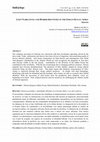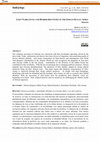Papers by Shihan de Silva

Indialogs, 2017
The voluntary movement of Africans was concurrent with their involuntary uprooting, driven by the... more The voluntary movement of Africans was concurrent with their involuntary uprooting, driven by the slave trade. Trade, colonisation and slavery have been drivers of migration, interconnecting people of diverse ethnicity globally. Afro-Asian communities are both historic and contemporary and, whilst Afro-diasporic communities in the Atlantic World are well recognised, the diasporas in Asia have only become visible in the last decade. Assimilation to the diversity of the Indian Ocean has contributed to this invisibility. With the loss of patronage due to changing political scenarios, African migrants have become disenfranchised. The dynamics of their identity, shaped by strong cultural memories bring out their African roots. This paper argues that diasporic consciousness of Afro-Asians is expressed through their strong cultural memories. As people with dual belongings, identifying with both the homeland and the hostland, Afro-Asians are able to reconcile their hybrid identities. With the movement of Afro-Asians from the peripheries their subaltern voices are beginning to be heard. Their eclipsed histories and lost narratives are challenging the Atlantic model of African migration.

African Diaspora, 2008
African movement in the Indian Ocean is a centuries old phenomenon. The better-known transatlanti... more African movement in the Indian Ocean is a centuries old phenomenon. The better-known transatlantic migration to the Americas has gripped scholars and the public imagination particularly due to the commemorations, in 2007, of the bicentennial of Britain abolishing the slave trade. Archival and oral accounts are complementary in investigating the silent history of the Indian Ocean involuntary migrants. Through case studies, assimilation, social mobility, marginalisation and issues of identity, perhaps we can begin to understand the contemporary status endured by Asia's Africans. This paper considers African influence in the Indian Ocean World through retention and transmission of music while exploring identity and contemporary culture of Afro-Asians. La migration africaine à travers l'océan Indien est un phénomène vieux de plusieurs siècles. Plus connue, la migration transatlantique vers les Amériques a focalisé l'attention des chercheurs ainsi que l'imagination du pub...

Lusotopie, 2005
The Afro-Sri Lankans are an ethnic minority who have long been overlooked and have received littl... more The Afro-Sri Lankans are an ethnic minority who have long been overlooked and have received little academic attention. They are a marginalised group, part of a culture which is undergoing rapid assimilation, and any information that we have at present about them may be lost if it is not recorded. There is as yet no adequate history of the Afro-Sri Lankans. The three waves of European colonisers (Portuguese, Dutch and British) that came to the shores of Sri Lanka brought Africans with them to this island in the Indian Ocean. This paper focuses on the largest Afro-Sri Lankan contemporary community. Since Sri Lanka regained its independence, the Afro-Sri Lankans have had to cope with the socio-political changes that have occurred in postcolonial Sri Lanka. The Portuguese identity of the Afro-Sri Lankans is expressed through language, religion, music, song and dance. L'identité portugaise des Afro-Sri Lankais Les Afro-Sri Lankais constituent une minorité ethnique qui a été longtemps négligée et à laquelle les universitaires n'ont pas accordé une grande attention. Ils forment un groupe marginalisé, appartenant à une culture qui est en train de subir une assimilation rapide. Toutes les informations que nous possédons actuellement à leur sujet pourraient être perdues si elles ne sont pas recueillies. Il n'existe pas encore d'histoire adéquate des Afro-Sri Lankais. Les trois vagues de colons européens (portugais, hollandais et britanniques) qui ont atterri sur les rivages du Sri Lanka ont amené avec eux des Africains sur cette île de l'Océan Indien. Cet article s'intéresse à la plus importante communauté afro-sri lankaise contemporaine. Depuis que le Sri Lanka a regagné son indépendance, les Afro-Sri Lankais ont dû faire face aux changements sociopolitiques qui sont intervenus dans le Sri Lanka postcolonial. L'identité portugaise des Afro-Sri Lankais se traduit à travers la langue, la religion, la musique, le chant et la danse. A identidade portuguesa dos afro-sri lankanos Os afro-sri lankanos constituem uma minoria étnica desde há muito esquecida, à qual os académicos não têm dado grande atenção. Constituem um grupo marginalizado que faz parte de uma cultura que se encontra em fase de rápida assimilação. Qualquer informação de que disponhamos de momento sobre esse grupo poderá ser perdida se não for registada. Ainda não existe uma história adequada dos afro-sri lankanos. As três ondas de colonizadores europeus (portugueses, holandeses e britânicos) que desembarcaram nas costas do Sri Lanka levaram africanos para esta ilha do Sri Lanka, no Oceano Índico. O presente artigo debruça-se sobre a maior comunidade afro-sri lankana de hoje. Desde que o Sri Lanka recuperou a sua independência, os afro-sri lankanos têm enfrentado as mudanças sócio-políticas que aí ocorreram no período pós-colonial. A identidade portuguesa dos afro-sri lankanos é assinalada pela língua, pela religião, pela música, pelo canto e pela dança.

Journal of International Migration and Integration, 2014
I highly recommend Matthias Weinreich's incisive book on the entrepreneurial migrations and settl... more I highly recommend Matthias Weinreich's incisive book on the entrepreneurial migrations and settlements of Pashto-speaking peoples or Pashtuns from Western Pakistan, Afghanistan and other regions to the Northern Areas of Pakistan since the midnineteenth century to the mid-1990s. Arguably, it constitutes the first 'comprehensive' treatment of "Pashtun migration in the Northern Areas" (p. 7), and thus, a single-case study has been necessary to "fill this gap" in empirical knowledge (p. 7). Weinreich's findings can contribute to an increased insight about migrant behaviour. Yet-and that is my only major criticism-Weinreich has not put his research in any comparative or theoretical context. Numerically, the presence of Pashtuns or 'Pathans' in the Northern Areas-since 2009, known as the autonomous province of Gilgit-Baltistan 1-is still quite small; Weinreich estimates that, in the mid-1990s, they constitute just below 1 % of the region's 600,000 inhabitants (pp. 13, 19) (though much higher estimates exist of 900,000 people or more). Nevertheless, their impact as entrepreneurs in trade, craftsmanship and other professions is disproportionate to their numbers, helped by the fact that they-as entrepreneurs-are concentrated in the cities and towns of that province. The main findings presented in this book, and in the preceding German language publications in the journal Iran and the Caucasus (Brill) in 2001 and 2005 (see references), are based on field research that Weinreich has conducted between 1993 and 1997 in the four districts of the Northern Areas. These districts include the greater part of the Karakoram mountain range: Gilgit, Ghizer, Diamer, Skardu and Ganche (a part of eastern Diamer became a separate district called Astor in 2004). Weinreich, an accomplished anthropologist and currently stationed in Armenias for the International Committee of the Red Cross (ICRC), has unearthed the life histories of Pashtun migrants and (other) local inhabitants, through informal, unstructured interviews mostly conducted in Pashto or through an interpreter in Urdu, the official Hindi language of
International Social Science Journal, 2006
African and Asian Studies, 2011
African and Asian Studies, 2007

The voluntary movement of Africans was concurrent with the involuntary uprooting of these peoples... more The voluntary movement of Africans was concurrent with the involuntary uprooting of these peoples, driven by the slave trade. Trade, colonisation and slavery have been drivers of migration, interconnecting people of diverse ethnicity globally. We assure that Afro-Asian communities are both historic and contemporary and, whilst Afro-diasporic communities in the Atlantic World are well recognised, the diasporas in Asia have only become visible in the last decade. Assimilation to the diversity of the Indian Ocean has contributed to this invisibility. With the loss of patronage due to changing political scenarios, African migrants have become disenfranchised. The dynamics of their identity, shaped by strong cultural memories bring out their African roots. This paper argues that diasporic consciousness of Afro-Asians is expressed through their strong cultural memories. As people with dual belongings, identifying with both the homeland and the hostland, Afro-Asians are able to reconcile t...
Orientalistische Literaturzeitung, 2014
Journal of the Royal Asiatic Society, 1999
Sri Lanka Portuguese Creole is considered to fall within the group of Indo-Portuguese Creoles, wh... more Sri Lanka Portuguese Creole is considered to fall within the group of Indo-Portuguese Creoles, which were Portuguese-based Creoles that once flourished around coastal India and Sri Lanka. Sri Lanka Portuguese Creole arose when the Portuguese established trading posts and fortresses in Sri Lanka from 1517 onwards. The purpose of this paper is to examine critically the influence of substratum (indigenous) languages on Sri Lanka Portuguese Creole.
African and Asian Studies, 2006
In Asia, Africans have been referred to by various names over time and space. Many Africans who m... more In Asia, Africans have been referred to by various names over time and space. Many Africans who migrated to Asia were assimilated to the host societies making identification problematic. The different labels given to Africans in Asia accentuate the problem. Moreover, Africans were not perceived to have come from a unified entity. This paper draws attention to the different terms used for Africans in Asia and considers the rationale for the existence of numerous terms. The problems of identification have to be overcome before a comprehensive study of African migration to Asia is conducted.
African and Asian Studies, 2009
African and Asian Studies, 2011
This paper focuses on the displacement of Africans, spurred by the tradition of recruiting soldie... more This paper focuses on the displacement of Africans, spurred by the tradition of recruiting soldiers to serve in both Asian and European armies. It considers the pressure to recruit Africans to the British regiments in Ceylon (called Sri Lanka since 1971) as documented in historical records in the National Archives and how this process was affected by Abolition in the Atlantic. It highlights the spillover effects, of abolishing the transatlantic slave trade, into other oceans.
African and Asian Studies, 2007
This paper seeks to understand why people of African descent in Sri Lanka have a low profile. Dra... more This paper seeks to understand why people of African descent in Sri Lanka have a low profile. Drawing attention to cultural retentions and transformations, it examines the process of their assimilation within post-independent Sri Lanka. It argues that the fate of today's Afro-Sri Lankans was shaped during the British era. The prestige of Afro-Sri Lankans rested on their military abilities. Turning to their contemporary status, it appears that their considerable talents as musicians and dancers have not been adequately recognised and nurtured. These internationally marketable assets need to be supported through aid.
Revue internationale des sciences sociales, 2006
Dans Revue internationale des sciences sociales Revue internationale des sciences sociales 2006/2... more Dans Revue internationale des sciences sociales Revue internationale des sciences sociales 2006/2 (n° 188) 2006/2 (n° 188), pages 231 à 240 Éditions Érès Érès
STUF - Language Typology and Universals, 2003
Bulletin of the School of Oriental and African Studies, 1996
The Portuguese presence in Sri Lanka dates back to the early sixteenth century and lasted some hu... more The Portuguese presence in Sri Lanka dates back to the early sixteenth century and lasted some hundred and fifty years. It gave rise to a Creole language based on Portuguese, Sri Lanka Portuguese Creole (SLPC), which Dalgado (1936) considered to be the most vigorous of the Portuguese Creoles.
African and Asian Studies, 2006
African and Asian Studies, 2009
Although Sri Lanka has had links with the Malays from ancient times, the Sri Lankan Malays trace ... more Although Sri Lanka has had links with the Malays from ancient times, the Sri Lankan Malays trace their ancestry only from the mid-seventeenth century. Taking into account the process of global commercial interactions and territorial expansion, this paper demonstrates the effects of cross-cultural contact in the language of the Sri Lanka Malays illustrated through typological alterations and lexical changes in a multilingual and multicultural setting.
African and Asian Studies, 2009
For scholars concerned with historical studies of cross-continental movement, migration from Afri... more For scholars concerned with historical studies of cross-continental movement, migration from Africa to Asia poses challenges. Administrative records of the East India Company reveal the multi-ethnicity of slaves, trends of slavery, resistance to slavery and the circumstances that led to emancipation of the slaves. Through a case study on Sumatra, this paper considers how transition from British to Dutch control affected the emancipated slaves, what rights they had and their eventual fate. It suggests that descendants of African slaves could still be living in Southeast Asia although creolisation and assimilation may have rendered them invisible.










Uploads
Papers by Shihan de Silva